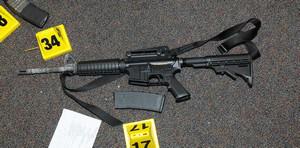GunsAssault weapons not protected by Second Amendment: U.S. appeals court
The U.S. Court of Appeals for the Fourth circuit ruled 10-4 to uphold Maryland’s ban on assault weapons, ruling that assault weapons are not protected under the Second Amendment of the U.S. Constitution. “Put simply, we have no power to extend Second Amendment protection to the weapons of war,” Judge Robert King wrote. “Both before and after Newtown, similar military-style rifles and detachable magazines have been used to perpetrate mass shootings in places whose names have become synonymous with the slaughters that occurred there,” he wrote.

A semi-automatic AR-15 "assault" rifle // Source: theconversation.com
The U.S. Court of Appeals for the Fourth circuit ruled 10-4 to uphold Maryland’s ban on assault weapons, ruling that assault weapons are not protected under the Second Amendment of the U.S. Constitution. The Maryland law was passed in response to the massacre in Newtown, Connecticut, in 2012.
“Put simply, we have no power to extend Second Amendment protection to the weapons of war,” Judge Robert King wrote, referring to the “military-style rifles” that were also used during mass shootings in Aurora, Colorado, San Bernardino, California, and Orlando, Florida.
“Both before and after Newtown, similar military-style rifles and detachable magazines have been used to perpetrate mass shootings in places whose names have become synonymous with the slaughters that occurred there,” King wrote.
[Aurora, San Bernardino, Orlando] are “places whose names have become synonymous with the slaughters that occurred there,” he added, noting the Supreme Court’s decision in the 2008 District of Columbia v Heller case excluded coverage of assault weapons.
King also noted that enacting the law is “precisely the type of judgment that legislatures are allowed to make without second-guessing by a court.”
“Simply put, the State has shown all that is required: a reasonable, if not perfect, fit between the (Firearms Safety Act) and Maryland’s interest in protecting public safety,” King wrote.
Maryland Attorney General Brian Frosh, who led the push for the law in 2013 as a state senator, said it is “unthinkable that these weapons of war, weapons that caused the carnage in Newtown and in other communities across the country, would be protected by the Second Amendment.”
“It’s a very strong opinion, and it has national significance, both because it’s en-banc and for the strength of its decision,” Frosh said, noting that all of the court’s judges participated.
Fox News reports that in total, seven states and the District of Colombia have laws banning semi-automatic rifles.
Four appeal courts have rejected Second Amendment challenges to bans on assault weapons and large-capacity magazines, King wrote.
In 2015, U.S. District Judge Catherine Blake upheld Maryland’s law banning the AR-15 and other military-style rifles and shotguns and limiting magazine capacity to ten rounds, but a smaller panel of circuit court judges reversed her ruling in 2016.
Legal analysts say the case could eventually be taken up by the Supreme Court.
The majority “has gone to greater lengths than any other court to eviscerate the constitutionally guaranteed right to keep and bear arms,” Judge William Traxler wrote in the dissent of the ruling. He also wrote that the court did not apply a strict enough review on the constitutionality of the law.
“For a law-abiding citizen who, for whatever reason, chooses to protect his home with a semi-automatic rifle instead of a semi-automatic handgun, Maryland’s law clearly imposes a significant burden on the exercise of the right to arm oneself at home, and it should at least be subject to strict scrutiny review before it is allowed to stand,” Traxler wrote.
The NRA estimates there are 5 million to 10 million AR-15s — one of the weapons banned under Maryland’s law — in circulation in the United States for lawful purposes.
NRA spokeswoman Jennifer Baker said, “It is absurd to hold that the most popular rifle in America is not a protected `arm’ under the Second Amendment.” She added that the majority opinion “clearly ignores the Supreme Court’s guidance from District of Columbia v. Heller that the Second Amendment protects arms that are `in common use at the time for lawful purposes like self-defense.”’
